Testing methodology
| Graphics Card | GPU Clock (MHz) |
Stream Processors |
Shader Clock (MHz) |
Memory Clock (MHz) |
Memory Bus (bits) |
Graphics Driver | Approx Price | |
|---|---|---|---|---|---|---|---|---|
| Nvidia GeForce GTX Titan 6GB | 837 (876) | 2,688 | 837 (876) | 6,008 | 384 | GeForce 320.18 | £790 | |
| Palit GeForce GTX 780 Super JetStream 3GB | 980 (1,033) | 2,304 | 980 (1,033) | 6,200 | 384 | GeForce 320.18 | £580 | |
|
Gigabyte GeForce GTX 780 WindForce 3X 3GB |
954 (1,006) | 2,304 | 954 (1,006) | 6,008 | 389 | GeForce 320.18 | £550 | |
| Nvidia GeForce GTX 780 3GB | 863 (902) | 2,304 | 863 (902) | 6,008 | 384 | GeForce 320.18 | £520 | |
| Nvidia GeForce GTX 770 2GB | 1,046 (1,085) | 1,536 | 1,046 (1,085) | 7,008 | 256 | GeForce 320.18 | £310 | |
| Nvidia GeForce GTX 760 2GB | 980 (1,033) | 1,152 | 980 (1,033) | 6,008 | 256 | GeForce 320.39 | £200 | |
| Nvidia GeForce GTX 680 2GB | 1,006 (1,058) | 1,536 | 1,006 (1,058) | 6,008 | 256 | GeForce 320.18 | £350 | |
| Nvidia GeForce GTX 670 2GB | 915 (980) | 1,344 | 915 (980) | 6,008 | 256 | GeForce 320.18 | £280 | |
| Nvidia GeForce GTX 660 Ti 2GB | 950 (1,013) | 1,344 | 950 (1,013) | 6,008 | 192 | GeForce 320.18 | £220 | |
| Nvidia GeForce GTX 580 1.5GB | 772 | 512 | 1,544 | 4,008 | 256 | GeForce 320.18 | NA | |
| AMD Radeon HD 7970 GHz 3GB | 1,000 (1,050) | 2,048 | 1,000 (1,050) | 6,000 | 384 | Catalyst 13.5 beta 2 | £320 | |
| AMD Radeon HD 7970 3GB | 925 | 2,048 | 925 | 5,500 | 384 | Catalyst 13.5 beta 2 | £280 | |
| AMD Radeon HD 7950 3GB | 850 | 1,792 | 850 | 5,000 | 384 | Catalyst 13.5 beta 2 | £215 | |
| AMD Radeon HD 7870 2GB | 1,000 | 1,280 | 1,000 | 4,800 | 256 | Catalyst 13.5 beta 2 | £170 | |
| AMD Radeon HD 5870 1GB | 850 | 1,600 | 800 | 4,800 | 256 | Catalyst 13.5 beta 2 | NA |
| Processor | Intel Core i7-3770K (3.50GHz, 8MB cache, quad-core) |
|---|---|
| CPU Cooler | Intel reference E97378-001 |
| Motherboard | Gigabyte GA-Z77X-UP4 TH |
| Memory | 8GB G.Skill RipJaws (2x4GB) DDR3 @ 1,600MHz |
| Power Supply | Corsair AX750W |
| Storage Device | Samsung 830 Series 256GB SSD |
| Optical Drive | Generic 24x DVD-RW |
| Chassis | Corsair Graphite Series 600T |
| Monitor | Dell 3007FPW |
| Operating system | Windows 7 Ultimate (64-bit, SP1) |
| GPU Benchmarks | Mode and Resolutions | Quality Settings |
|---|---|---|
| 3DMark | DX11 at 1,920×1,080 and 2,560×1,440 | Fire Strike and Fire Strike Extreme |
| BioShock Infinite | DX11 at 1,920×1,080 and 2,560×1,600 | Ultra + DOF |
| Call of Duty: Black Ops II | DX9 at 1,920×1,080 and 2,560×1,600 | 8xMSAA, High/Extra Preset |
| Crysis 3 | DX11 at 1,920×1,080 and 2,560×1,600 | 4xMSAA, High Preset |
| DiRT Showdown | DX11 at 1,920×1,080 and 2,560×1,600 | 4xMSAA, Ultra Preset |
| Far Cry 3 | DX11 at 1,920×1,080 and 2,560×1,600 | 2xMSAA, Ultra Preset |
| Just Cause 2 | DX10 at 1,920×1,080 and 2,560×1,600 | 8xMSAA, High Preset |
| General Benchmarks | Description | |
| Power Consumption | To emulate real-world usage scenarios, we record mains power draw both when idle and while playing Far Cry 3 | |
| Temperature | To emulate real-world usage scenarios, we record GPU core temperature both when idle and while playing Far Cry 3 | |
| Noise | A PCE-318 meter is used to record noise levels when idle and while playing Far Cry 3 |
Notes
We measured the in-game frequency across our six games. The Super JetStream ran at an improbable 1,124MHz core in all but Crysis 3, where it dropped to 1,112MHz. These speeds are way in excess of the comparison Gigabyte card and some 25 per cent higher than the reference.
⇡#Тестовый стенд, методика тестирования
| Конфигурация тестовых стендов | ||
| CPU | Intel Core i7-3960X @ 4,6 ГГц (100 × 46) | |
| Материнская плата | ASUS P9X79 Pro | |
| Оперативная память | DDR3 Kingston HyperX 4 × 2 Гбайт, 1600 МГц, CL9 | |
| ПЗУ | Intel SSD 520 240 Гбайт | |
| Блок питания | Corsair AX1200i, 1200 Вт | Seasonic Platinum-1000, 1000 Вт |
| Охлаждение CPU | Thermalright Archon | |
| Корпус | CoolerMaster Test Bench V1.0 | |
| Операционная система | Windows 8.1 Pro X64 | |
| ПО для GPU NVIDIA | 347.25 |
Для измерения мощности системы используется стенд с блоком питания Corsair AX1200i. Энергосберегающие технологии CPU во всех тестах отключены. Шина PCI-Express работает в режиме 3.0. Для активации PCI-E 3.0 на видеокартах серий GeForce 600 и 700 в системе на чипсете X79 применяется патч от NVIDIA.
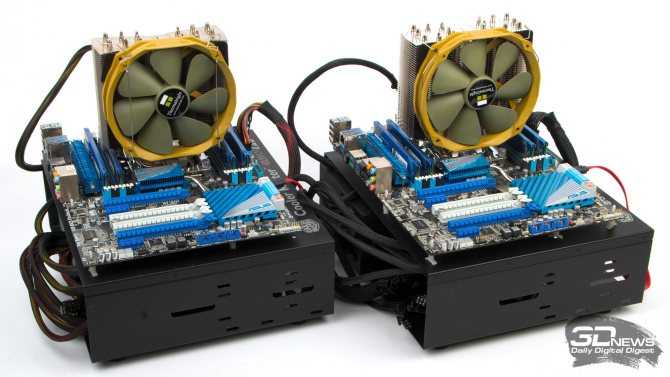
В настройках драйвера NVIDIA всегда в качестве процессора для вычисления PhysX выбирается CPU.
| Бенчмарки: синтетические | ||||
| Программа | API | Настройки | Анизотропная фильтрация, полноэкранное сглаживание | Разрешение |
| 3DMark 2011 | DirectX 11 | Тест Extreme | – | – |
| 3DMark | DirectX 11 | Тест Fire Strike (не Extreme) | – | – |
| Unigine Heaven 4 | DirectX 11 | DirectX 11, макс. качество, тесселяция в режиме Extreme | AF 16x, MSAA 4x | 1920 × 1080 / 2560 × 1440 |
| Бенчмарки: игры | ||||
| Программа | API | Настройки | Анизотропная фильтрация, полноэкранное сглаживание | Разрешение |
| Far Cry 3 + FRAPS | DirectX 11 | DirectX 11, макс. качество, HDAO. Начало миссии Secure the Outpost | AF, MSAA 4x | 1920 × 1080 / 2560 × 1440 |
| Tomb Raider. Встроенный бенчмарк | DirectX 11 | Макс. качество | AF 16x, SSAA 4x | 1920 × 1080 / 2560 × 1440 |
| Bioshock Infinite. Встроенный бенчмарк | DirectX 11 | Макс. качество. Postprocessing: Normal | AF 16x, FXAA | 1920 × 1080 / 2560 × 1440 |
| Crysis 3 + FRAPS | DirectX 11 | Макс. качество. Начало миссии Post Human | AF 16x, MSAA 4x | 1920 × 1080 / 2560 × 1440 |
| Metro: Last Light. Встроенный бенчмарк | DirectX 11 | Макс. качество | AF 16x, SSAA 4x | 1920 × 1080 / 2560 × 1440 |
| Company of Heroes 2. Встроенный бенчмарк | DirectX 11 | Макс. качество | AF, SSAA 4x | 1920 × 1080 / 2560 × 1440 |
| Batman: Arkham Origins. Встроенный бенчмарк | DirectX 11 | Макс. качество | AF, MSAA 4x | 1920 × 1080 / 2560 × 1440 |
| Battlefield 4 + FRAPS | DirectX 11 | Макс. качество. Начало миссии Tashgar | AF 16x, MSAA 4x + FXAA | 1920 × 1080 / 2560 × 1440 |
| Thief. Встроенный бенчмарк | DirectX 11 | Макс. качество | AF 16x, SSAA 4x + FXAA | 1920 × 1080 / 2560 × 1440 |
Performance
3DMark 2013
The Cloud Gate scene is too CPU-dependent to reveal the potential of these top-class graphics subsystems, therefore we should consider the Fire Strike results, especially at the extreme graphics quality settings. The GeForce GTX 780 SLI tandem shows good scalability, being 70.7% faster than the single GTX 780 and enjoying a large advantage over both dual-processor products from AMD and Nvidia. The difference between the MSI and Palit is insignificant.
We can see the same picture in the Unigine Valley benchmark. At high loads (with enabled antialiasing) the GeForce GTX 780 tandem is 78.5% faster than the single GTX 780 and beats both dual-processor flagship cards. And again, there is hardly any difference between the MSI and Palit at their factory settings.
Total War: SHOGUN 2 – Fall of the Samurai
The MSI GeForce GTX 780 OC Gaming is roughly equal to the Palit GeForce GTX 780 Super JetStream in this game, too:
The GeForce GTX 780 tandem feels very good here. It is 83 to 86% faster than the single card with enabled antialiasing and enjoys a 25-31% advantage over the overclocked dual-processor GeForce GTX 690. None of these graphics subsystems has any bottom speed problems, by the way.
Battlefield 3
The top-class graphics subsystems we’re benchmarking today are overkill for this game:
Although the actual gameplay is going to be 20-30% slower than in the intro scene we use for our benchmarking, even a single GeForce GTX 780 is enough for playing Battlefield 3 at the maximum settings and highest resolutions. There’s no reason to build a 2-way SLI tandem out of GTX 780s for playing this game, but if you do, you will enjoy a performance boost of 65 to 82% in comparison with the single card and 20-30% in comparison with the GeForce GTX 690. By the way, the latter is slower than the dual-processor card from AMD here.
Sleeping Dogs
It is clear that Sleeping Dogs is only good for benchmarking top-performance graphics cards and, especially, SLI configurations when we turn on antialiasing. The GeForce GTX 780 tandem is good here, outperforming the single GTX 780 by 80% and the GeForce GTX 690, by about 25%.
Hitman: Absolution
This test turned out to be even more CPU-dependent than Sleeping Dogs:
Yet we can again see the SLI tandem show high scalability (47 to 73%), so it beats both its dual-processor opponents. The GeForce GTX 690 is the only card to have low bottom speed in this game, which may be due to the lack of graphics memory.
Crysis 3
The idea of combining two top-end cards like overclocked GeForce GTX 780s into a SLI tandem was hardly justifiable in the previous games, but turns out optimal for Crysis 3:
The scalability of SLI technology is 71 to 80% here. Although no record, it ensures a comfortable frame rate in Crysis 3 even at the maximum settings. The SLI tandem beats the dual-processor cards. None of them has any problems with bottom speed here.
Tomb Raider (2013)
The GeForce GTX 780 tandem is even more efficient in this game:
The SLI scalability is over 92% at certain settings. As a result, the SLI tandem beats the Nvidia GeForce GTX 690 by 32% and the Radeon HD 7990 by 15% and more. There’s a very small difference between the original cards from MSI and Palit although the latter has higher GPU and memory clock rates. We can see no bottom speed problems here, but they appear in the next test, BioShock Infinite.
BioShock Infinite
The 2-way SLI configuration is less efficient in this game, providing a performance boost of 65 to 74% depending on the visual quality settings and display resolution. That’s enough to beat the two overclocked dual-processor cards, though.
Metro: Last Light
Here are the results with Advanced PhysX enabled:
Adding a second GeForce GTX 780 doesn’t produce a great effect in Metro: Last Light. The frame rate only grows by 40-54% without antialiasing and by 57-72% with SSAA. Anyway, the two GeForce GTX 780s easily beat the GeForce GTX 690 as well as the Radeon HD 7990. The latter is very slow, especially in terms of bottom speed, but improves somewhat when we turn off the Advanced PhysX option:
The rest of the standings haven’t changed.
GRID 2
Like Battlefield 3, GRID 2 isn’t a difficult test for top-end graphics cards, so it is no wonder that the SLI technology cannot show its maximum efficiency here.
Company of Heroes 2
The SLI technology works in Company of Heroes and is even very efficient with enabled antialiasing whereas CrossFireX fails, judging by the results of the AMD Radeon HD 7990. There are no problems in terms of bottom speed. The MSI and Palit cards have very similar results.
Seite 1: Test: Palit GeForce GTX 780 Super Jetstream
Nachdem wir uns schon drei Modelle der GeForce GTX 780 von EVGA, Gigabyte und Inno3D angeschaut haben, folgt heute die Palit GeForce GTX 780 Super Jetstream, die sich gegenüber der «normalen» Jetstream-Variante durch eine nochmalige Taktsteigerung sowie die Verwendung des eigenen PCBs unterscheidet. Mit beiden Maßnahmen will Palit an die Spitze der Benchmarks und Messwerte. Ob dies gelingt, werden wir auf den folgenden Seiten genauer untersuchen.
Palit bietet drei Modelle der GeForce GTX 780 an. Zum einen eine Version im Referenzlayout mit den von NVIDIA vorgegebenen Taktraten (863/902/1502 MHz) und zum anderen die bekannte Jetstream-Variante mit Jetstream-Kühler, aber Referenz-PCB, aber immerhin erhöhten Taktraten von 902/954/1502 MHz für GPU-Basis-, GPU-Boost- und Speichertakt. Drittes Modell ist nun die Super Jetstream, mit nochmals erhöhten Taktraten von 980/1033/1553 MHz und dem eigenen PCB.

» Fotostrecke
Bevor wir die Palit GeForce GTX 780 Super Jetstream ausführlich vorstellen und durch unseren gewohnt breit angelegten Benchmark-Parcours jagen, werfen wir noch einen näheren Blick auf die Architektur des Grafikprozessors selbst.
Architektonische Eckdaten
Mit der GeForce GTX 780 entwickelte NVIDIA ein Bindeglied zwischen der GeForce GTX Titan und der beschleunigten GeForce GTX 680 alias GeForce GTX 770. Wie das High-End-Modell basiert auch die GeForce GTX 780 auf der GK110-GPU. Für die Referenzversion gilt: Bei zwölf SMX-Clustern zu jeweils 192 CUDA-Kernen kommen wir auf eine Gesamtanzahl von 2304 CUDA-Kernen für die GeForce GTX 780. Diese arbeiten mit einem Basis-Takt von 863 MHz und erreichen via GPU-Boost mindestens 902 MHz. Der mit 3072 MB im Vergleich zur GeForce GTX Titan nur halb so große GDDR5-Speicher arbeitet mit den üblichen 1502 MHz und ist über ein 384 Bit breites Speicherinterface angebunden, was zu einer Speicherbandbreite von 288,4 GB/Sek. führt. Aufgrund der Beschneidungen bei der Architektur sehen wir weiterhin 192 Textureinheiten und 48 ROPs. NVIDIA gibt eine Thermal Design Power von 250 Watt an.
| Palit GeForce GTX 780 Super Jetstream | |
|---|---|
| Straßenpreis | ab 590 Euro |
| Homepage | www.palit.biz |
| Technische Daten | |
| GPU | GK110 (GK110-300-A1) |
| Fertigung | 28 nm |
| Transistoren | 7,1 Milliarden |
| GPU-Takt (Base Clock) | 980 MHz |
| GPU-Takt (Boost Clock) | 1033 MHz |
| Speichertakt | 1552 MHz |
| Speichertyp | GDDR5 |
| Speichergröße | 3072 MB |
| Speicherinterface | 384 Bit |
| Speicherbandbreite | 298 GBit/Sek. |
| DirectX-Version | 11.0 |
| Shadereinheiten | 2304 (1D) |
| Textur Units | 192 |
| ROPs | 48 |
| Pixelfüllrate | 47,0 GPixel/Sek. |
| SLI/CrossFire | SLI |
Die Unterschiede bei der Palit GeForce GTX 780 Super Jetstream gegenüber der Referenzversion sind zunächst einmal beim Takt zu suchen. Anstatt mit 863 MHz arbeitet die GPU mit 980 MHz. Entsprechend hat sich auf der GPU-Boost-Takt von 902 auf 1033 MHz erhöht. Selbst für den Speicher sieht Palit eine Übertaktung von 50 MHz vor und lässt diesen mit 1553 MHz arbeiten. Trotz all diesen Übertaktungen ist die Palit GeForce GTX 780 Super Jetstream aber (zumindest auf dem Papier) nicht die schnellste GeForce GTX 780, die wir bisher testen durften. Noch immer Spitzenreiter ist die Inno3D iChill GeForce GTX 780 mit 1006/1046/1553 MHz. Dennoch sind wir natürlich gespannt, wie sich das Modell von Palit schlägt und auch die Messwerte, hier vor allem die Lautstärke, sind für viele potenzielle Käufer interessant.
<>Test: Palit GeForce GTX 780 Super JetstreamDas Testsample im Detail
Упаковка и комплектация.

Видеокарта Palit GTX 960 Super JetStream поставляется в довольно большой коробке, которая своими размерами больше подходит под топовый продукт, нежели для видеокарты среднего ценового сегмента. Но, с другой стороны, большая упаковка с продуманным расположением аксессуаров, обеспечивает качественную защиту содержимого от повреждений. Упаковка выполнена в строгом оформлении, на лицевой стороне мы видим название модели, и большой логотип семейства, к которому принадлежит данный ускоритель.

На тыльной стороне, по традиции, расположилось подробное описание графического ускорителя и его основных преимуществ.

Сама видеокарта Palit GTX 960 Super JetStream уложена в большой пластиковый лоток, закрывающий ускоритель со всех сторон.
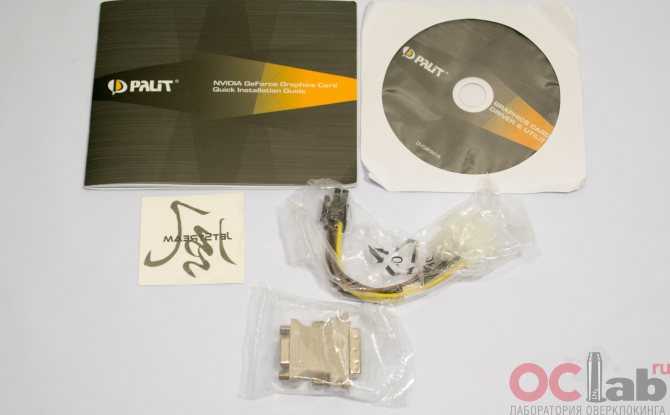
В комплекте с видеокартой поставляются следующие аксессуары: – Инструкция по эксплуатации; – Диск с ПО; – Переходник D-Sub->DVI; – Переходник для дополнительного питания 2xMolex-> 6-pin PCI-е; – Фирменная наклейка на корпус.
Noise Level and Power Consumption
The noise level of each cooler was measured between 1:00 and 3:00 AM in a closed room about 20 m2 big using CENTER-321 electronic noise meter. The noise level for each cooler was tested outside the system case when the only noise sources in the lab were the cooler and its fan. The noise meter was installed on a tripod and was always at a 150 mm distance from the cooler fan rotor. The tested cooling systems were placed at the edge of the desk on a sheet of polyurethane foam. The lowest noise reading our noise meter device can register is 29.8 dBA and the subjectively comfortable noise level in these testing conditions was around 36 dBA (do not mix it up with low noise level). The fan(s) rotation speed was adjusted in the entire supported range using our precise in-house controller by changing the voltage with 0.5 V increment.
The vertical dotted lines mark the peak speed of the coolers’ fans in the automatic speed regulation mode. Here’s the diagram:
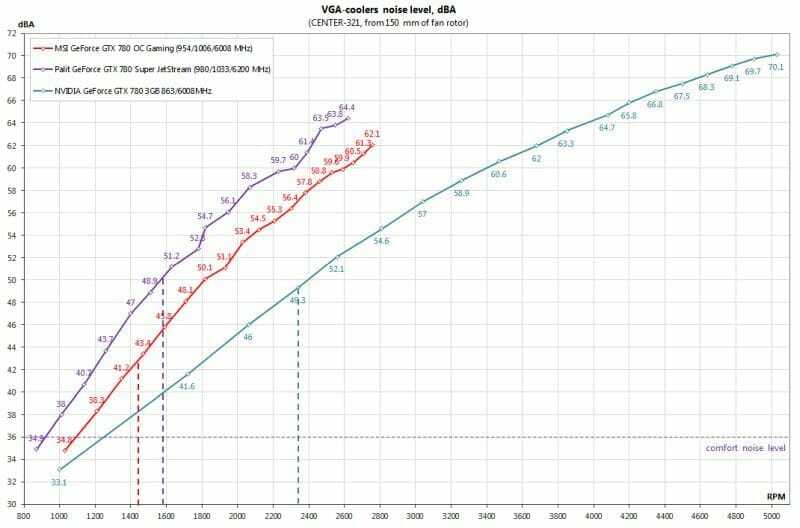
Although the noise level graphs of the MSI and Palit go higher than the reference GeForce GTX 780’s, only one of them is noisier in 3D applications. It is the Palit GeForce GTX 780 JetStream as you can easily see by the dotted line that shows the peak speed of the fans in the automatic regulation mode. But, frankly speaking, Palit’s cooler is not very different from Nvidia’s. The MSI GeForce GTX 780 OC Gaming, on its part, is quieter than both its opponents and is more comfortable subjectively, yet it can only be called silent in 2D applications. That said, we are still very fond of the MSI Twin Frozr IV cooler which is currently one of the best solutions available in terms of performance/noise ratio.
We measured the power consumption of our testbed equipped with different graphics cards using a multifunctional Zalman ZM-MFC3 panel which can report how much power a computer (without the monitor) draws from a wall outlet. There were two test modes: 2D (editing documents in Microsoft Word or web surfing) and 3D. In the latter case the load was created by four runs of the introductory “Swamp” scene in Crysis 3 game at 2560×1440 with maximum image quality settings, but without MSAA.
In our today’s power consumption tests we compare the original GeForce GTX 780s with two SLI-linked GTX 780s (at the same frequencies of 980/6208 MHz), AMD Radeon HD 7990 and Nvidia GeForce GTX 690 (we’ll use these dual-processor cards in our performance benchmarks as well).
It is the 2-way SLI configuration with two overclocked GeForce GTX 780s that needs the most power. It requires 114 watts more at peak load than the Nvidia GeForce GTX 690 configuration and 22 watts more than the dual-processor AMD Radeon HD 7990. The difference from the single GeForce GTX 780 is 223 watts, which is close to the specified power consumption of one GTX 780 (250 watts). We can also note that the difference between the configurations with the two GeForce GTX 780 cards from MSI and Palit is only 11 watts. It is due to the difference in the cards’ clock rates.
Дизайн и особенности
Графический адаптер RTX 3070 JetStream OC имеет исключительный дизайн системы охлаждения, который делает эту видеокарту непохожей на другие. Габариты ускорителя составляют 304 х 136 х 60 мм, что позволяет называть RTX 3070 JetStream OC трехслотовой.
Тыльную сторону печатной платы RTX 3070 JetStream OC надежно защищает металлический бэкплейт черного цвета.
Элементы светодиодной подсветки ARGB находятся на верхнем торце и на фронтальной стороне системы охлаждения RTX 3070 JetStream OC.
Для синхронизации ARGB подсветки предусмотрен коннектор 3-пин, расположенный на верхнем торце видеокарты слева. С помощью кабеля, идущего в комплекте пользователь может настроить синхронизацию подсветки, активировав в фирменном программном обеспечении ThunderMaster пункт «ARGB Sync». На тыльной стороне с угла можно обнаружить переключатель BIOS, позволяющий переключаться между двумя заводскими прошивками с разными лимитами энергопотребления и алгоритмами работы системы охлаждения.
По конструкции RTX 3070 JetStream OC представляет собой массивный бутерброд, большую часть которого составляет система охлаждения. По той причине, что печатная плата графического ускорителя заметно короче используемой системы охлаждения, коннекторы дополнительного питания 2х8-пин находятся практически посередине RTX 3070 JetStream OC.
При этом пластиковый кожух системы охлаждения закрывает радиатор не полностью, оставляя пространство для вентиляции печатной платы.
Правый торец RTX 3070 JetStream OC демонстрирует четыре никелированные тепловые трубки в теле радиатора системы охлаждения. Панель разъемов графического адаптера предлагает пользователю один HDMI 2.1 и три DisplayPort 1.4a, с помощью которых можно подключить до 4-х мониторов одновременно.
⇡#Технические характеристики, комплект поставки, цена
GeForce GTX 960 Super JetStream — самый быстрый среди нескольких вариантов GTX 960, которые выпускает Palit. Базовая частота GPU в нем повышена на 153 МГц от стандарта (1279 против 1126 МГц соответственно). Кроме того, производитель увеличил частоту оперативной памяти с 7010 до 7200 МГц — редкий случай, когда она разогнана с завода. Внимательный читатель заметит, что в таблице TDP видеокарты не отличается от референсного значения, но это явно ошибка со стороны Palit. Заводской разгон не мог не сказаться на энергопотреблении.
| Модель | Графический процессор | Видеопамять | Шина ввода/ вывода | TDP, Вт | |||||||||
| Кодовое название | Число транзис-торов, млн | Техпро-цесс, нм | Тактовая частота, МГц: Base Clock / Boost Clock | Число ядер CUDA | Число текстурных блоков | Число ROP | Разряд-ность шины, бит | Тип микросхем | Тактовая частота: реальная (эффективная), МГц | Объем, Мбайт | |||
| NVIDIA GeForce GTX 960 | GM206 | 2 940 | 28 | 1126/1178 | 1024 | 64 | 32 | 128 | GDDR5 SDRAM | 1753 (7010) | 2048 | PCI-Express 3.0 x16 | 120 |
| Palit GeForce GTX 960 Super JetStream | GM206 | 2 940 | 28 | 1279/1342 | 1024 | 64 | 32 | 128 | GDDR5 SDRAM | 1800 (7200) | 2048 | PCI-Express 3.0 x16 | 120 |
GeForce GTX 960 Super JetStream продается в стандартной для Palit громадной коробке. К устройству прилагается бумажная инструкция, диск с драйверами, переходник DVI-VGA и адаптер питания для соединения шестиконтактного разъема PCIe с двумя «молексами».
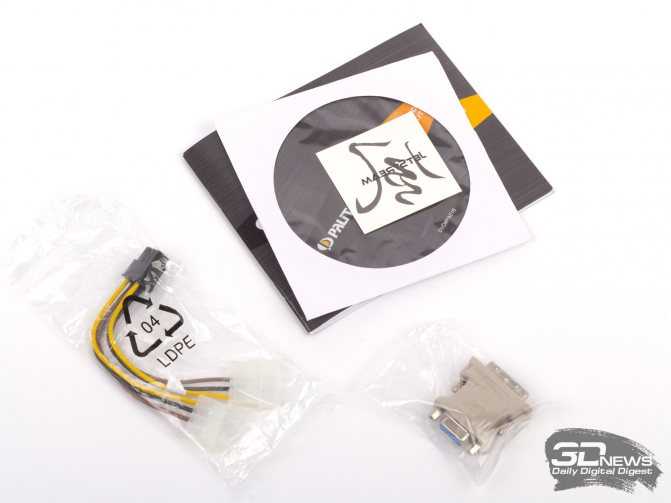
На момент публикации, по данным «Яндекс.Маркета», Palit GeForce GTX 960 Super JetStream в среднем стоил 16 тыс. рублей. Для сравнения: более простые версии GTX 960 с референсными частотами можно взять меньше чем за 14 тысяч.
Palit GeForce GTX 780 Super JetStream 3GB (NE5X780T10FB-1100J)
Palit Microsystems offers three GeForce GTX 780s: a copy of the reference card, a JetStream series model, and a Super JetStream model. The latter is going to be covered here.
The huge cardboard box is designed in Palit’s traditional style. The card’s model name, memory amount and technologies are listed on the front of the packaging. On the back, there is a detailed description of Nvidia innovations and system requirements for the GeForce GTX 780.
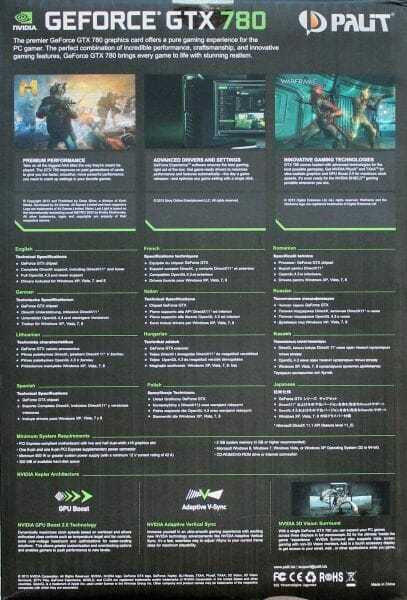
The box has a flip-back cover, so you can take a look at the card through a plastic window and read about its key features.
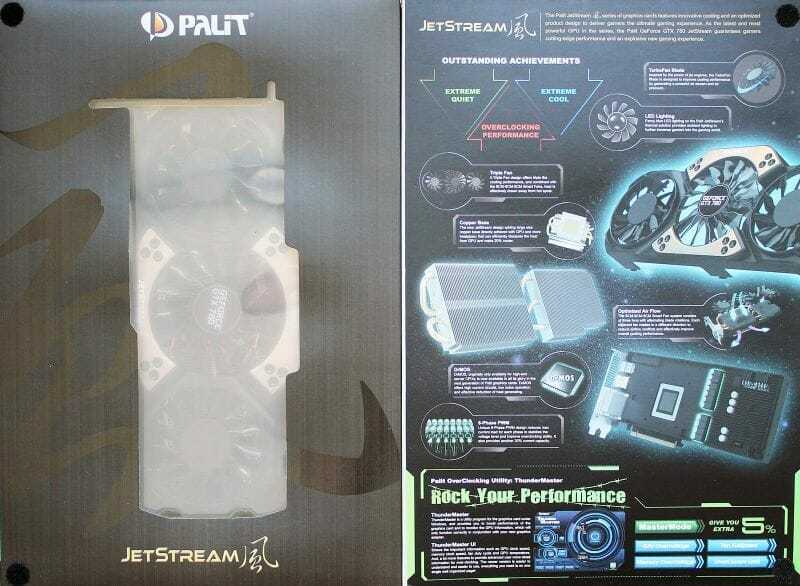
The accessories aren’t numerous for a top-class product: DVI->D-Sub and HDMI->DVI adapters, one power cable, a software CD, a brief installation guide, and a sticker.
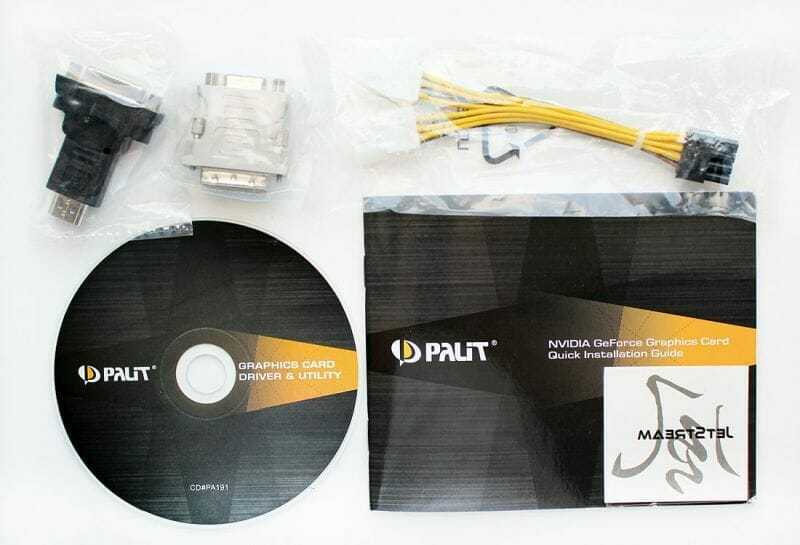
The Palit card is manufactured in China and comes with a 2-year warranty. We couldn’t find out its recommended price.
The Palit GeForce GTX 780 Super JetStream looks heavy. Its face side is covered with a cooling system that has a plastic frame with two gold-colored inserts. The central fan is larger and has a translucent impeller. The other two fans have ordinary black impellers.
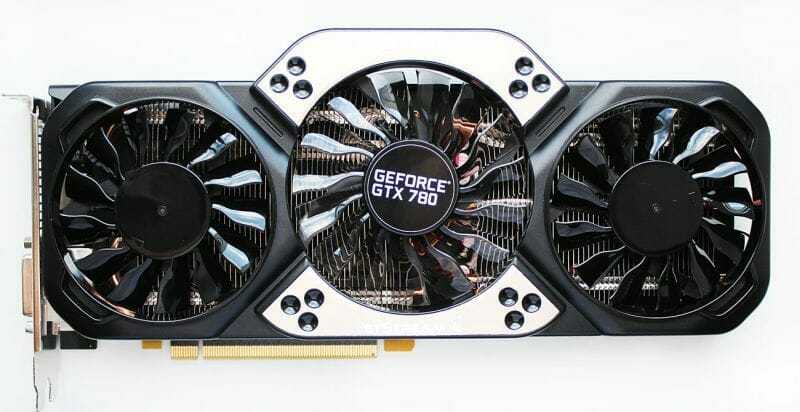
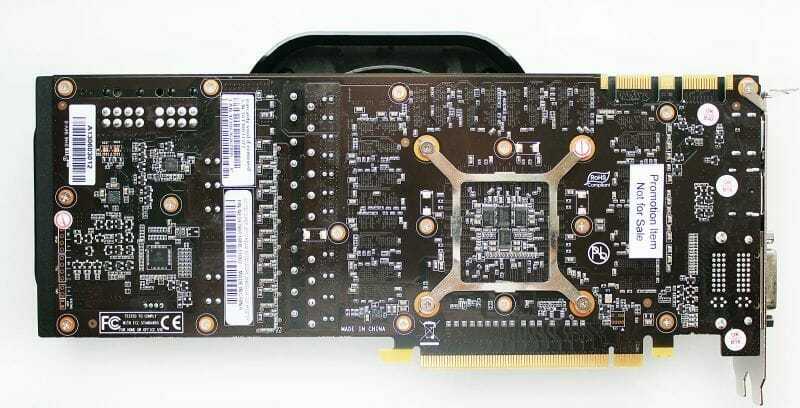
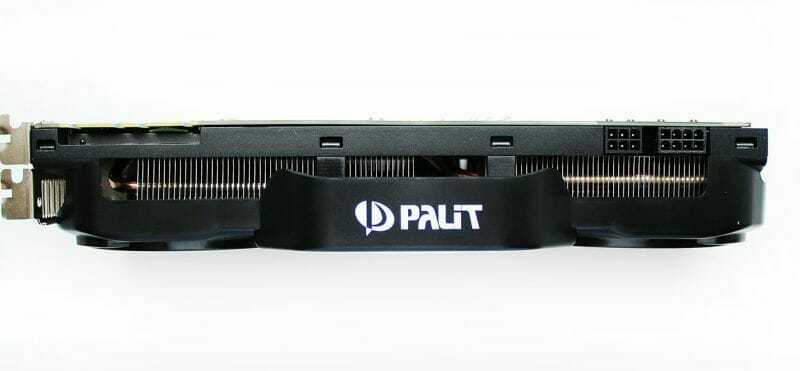
The graphics card is thicker than the reference GeForce GTX 780 at 280x119x51 mm, so in a SLI configuration it has to be installed into the bottom PCIe slot (or the mainboard must have two PCIe slots far apart from each other).
The Palit version is no different from the reference sample in terms of video, MIO and power connectors:
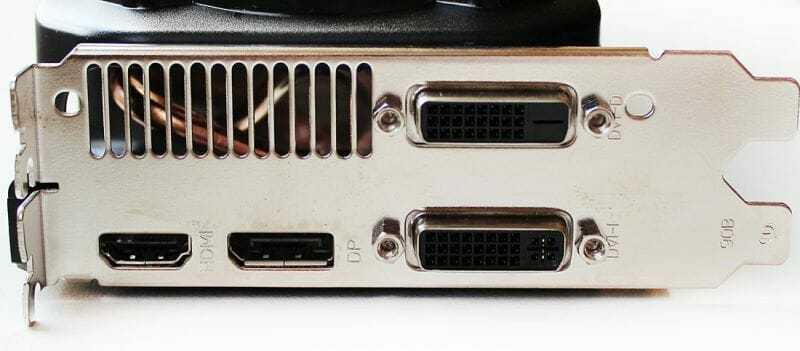
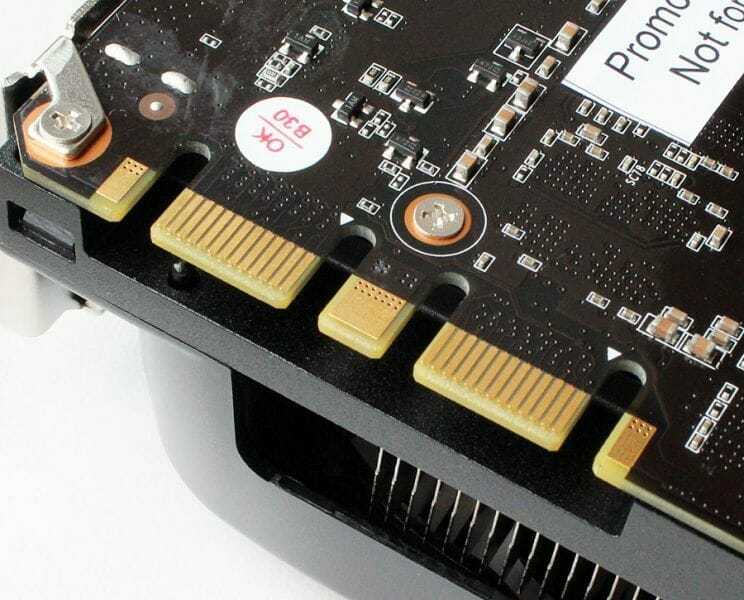
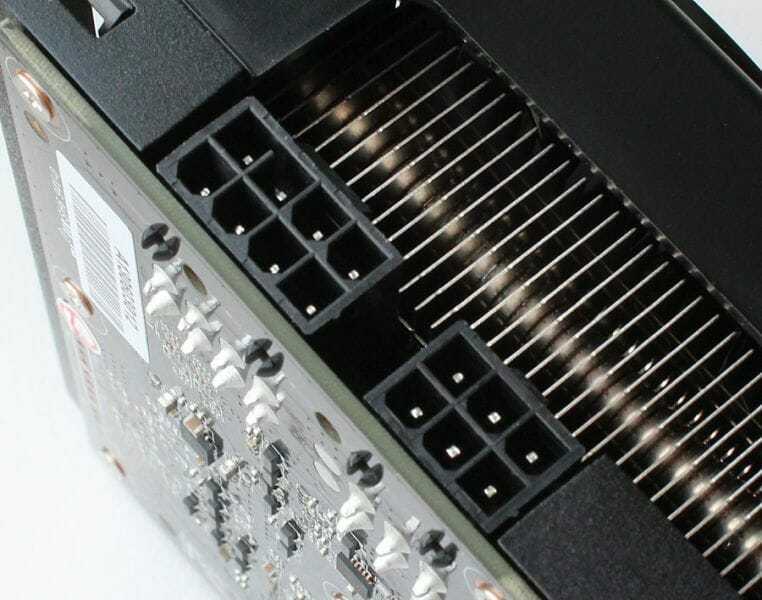
The GeForce GTX 780 Super JetStream features an original PCB:

The 8-phase GPU voltage regulator is based on DrMOS transistors:
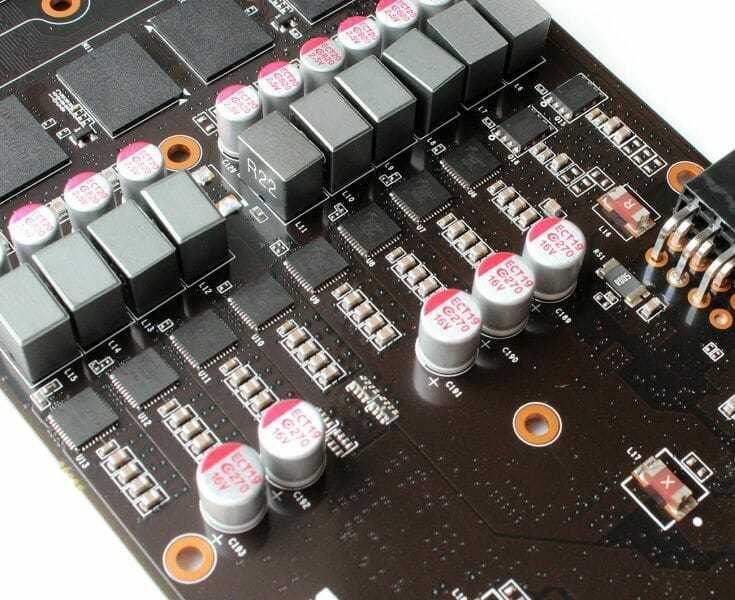
It is managed by an NCP4208 controller:
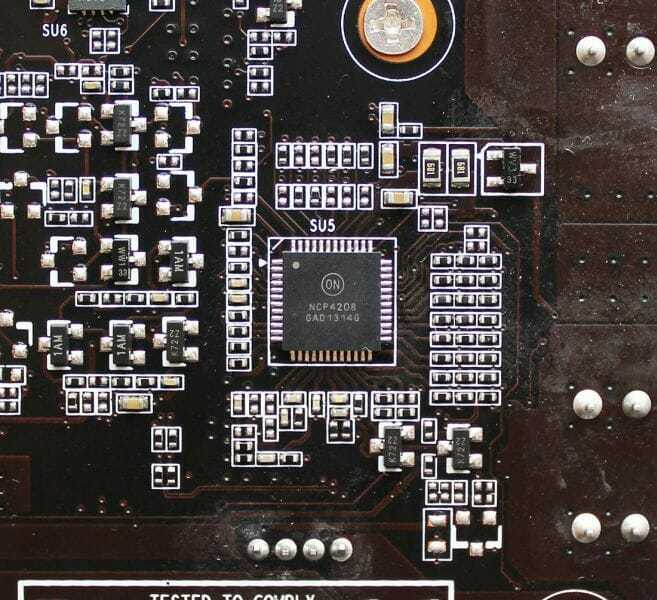
There are also two power phases for the memory chips.
The PCB has three check points for measuring GPU, memory and PLL voltages.
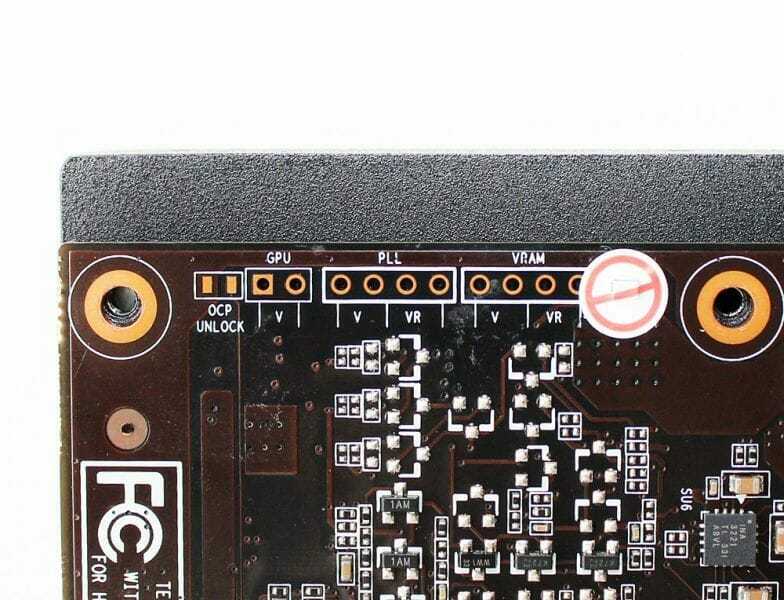
The OCP Unlock feature you can see nearby seems to be used to remove any limitations on voltages, power targets and frequencies. So, it looks like we have a good toolset for extreme overclocking here, although Palit has never positioned itself as a brand for hardcore overclockers.
The GPU of the Palit card was manufactured on the same week as the MSI’s. It is revision A1, too.
Its frequencies in 3D mode are pre-overclocked by 13.6% to 980/1033 MHz. The ASIC quality of the chip is 66%.
The card’s graphics memory is pre-overclocked as well. Instead of 6008 MHz, it works at 6200 MHz. These are the same Samsung chips as we’ve seen on the MSI:
Here are the specifications of the super card from Palit:
The cooling system consists of three separate components: a plastic frame with three fans, a dual-section GPU heatsink, and a steel heat-spreader on the memory chips and power components.
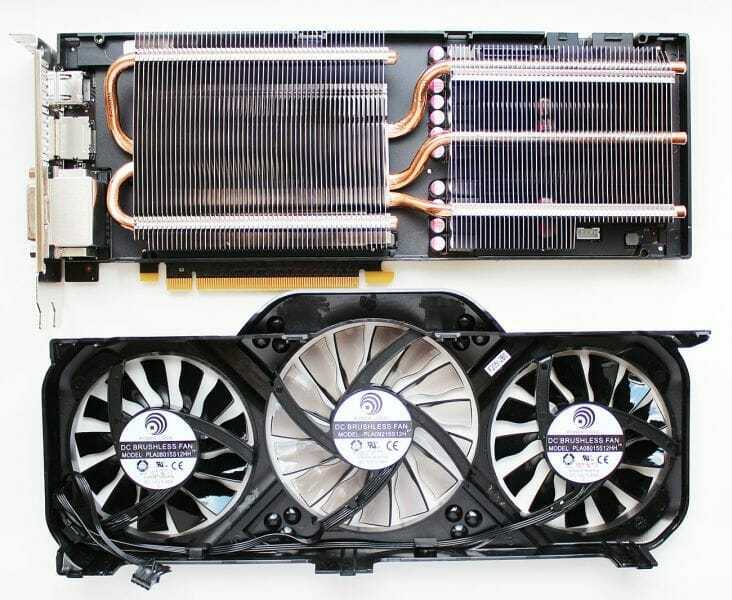
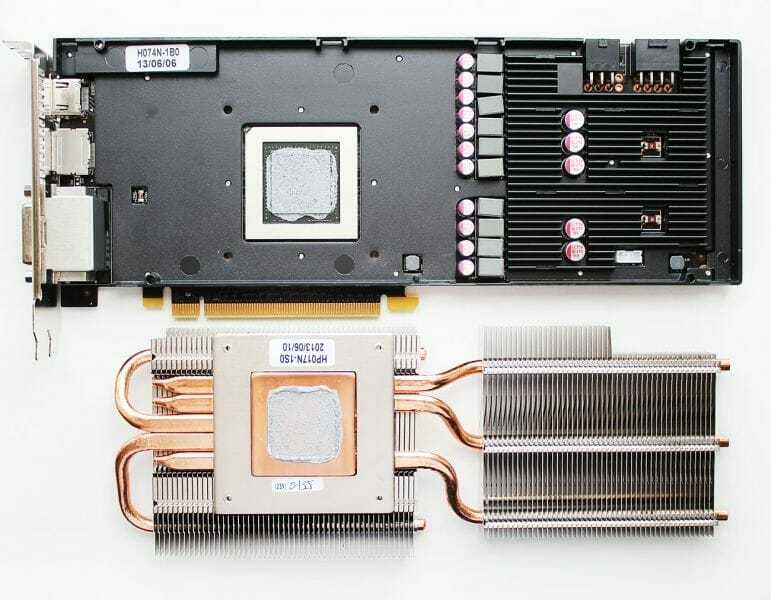
The steel heat-spreader envelops the PCB like a kind of thermal armor that has additional fins on the transistors.

The GPU heatsink consists of two sections and has five copper heat pipes, 6 mm in diameter. Two of them pierce the main section that has a copper base. The other three service the auxiliary section of the heatsink.

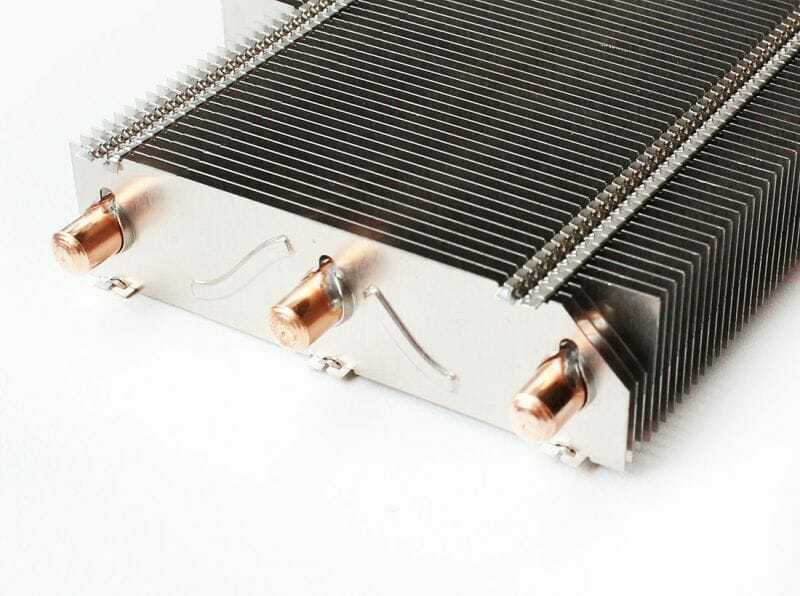
There’s a lot of aluminum fins soldered to the heat pipes. The cooler is neatly assembled and rather heavy.
There are three fans cooling the heatsink. The central fan has a diameter of 92 mm and a highlighted translucent impeller. The two other fans are only 80mm in diameter.
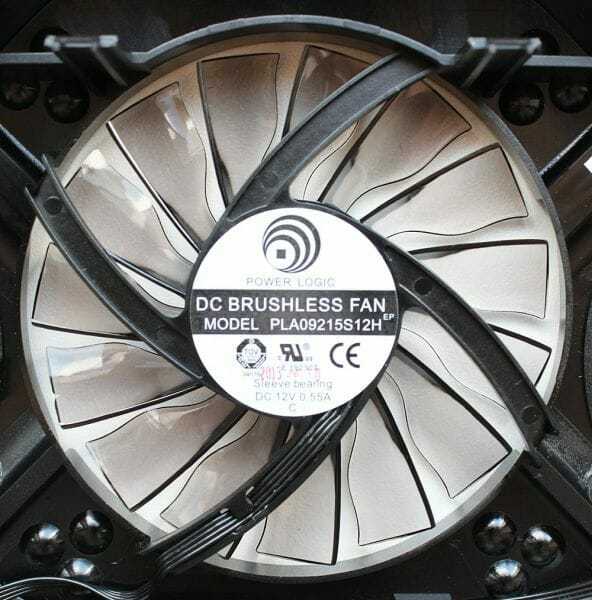
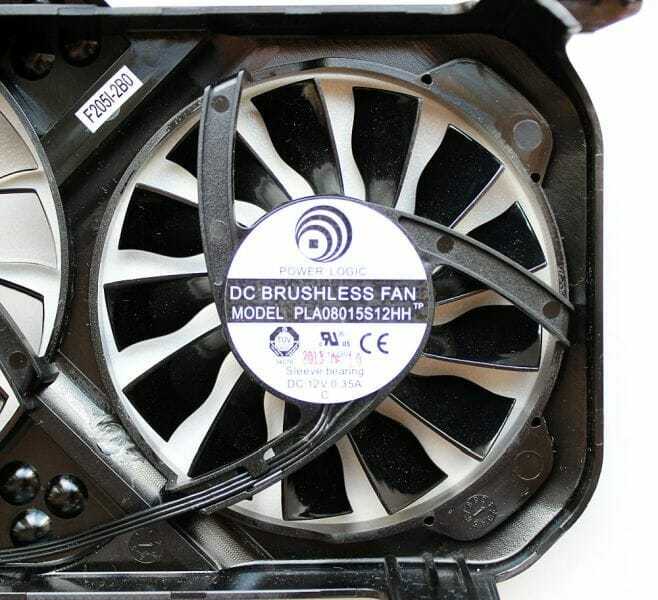
All of them are manufactured by Power Logic, run on fluid dynamic bearings and support PWM-based regulation. Their speed varies from 800 to 2800 RPM.
Palit’s cooler is no less efficient than MSI’s. With the fans regulated automatically (1580 RPM), the GPU is 77°C hot. It’s the same temperature as with the MSI, but the Palit’s GPU works at a higher clock rate.

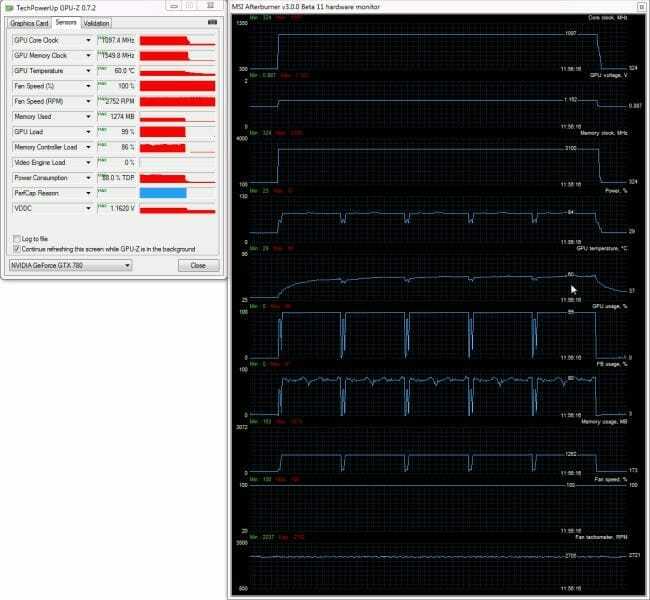
At the maximum speed of 2750 RPM the GPU is somewhat colder at 60° than on the MSI card. That’s just an excellent result.
Unfortunately, the Palit was not as good in our overclocking experiments as the MSI. We only managed to increase its GPU and memory clock rates by 65 and 1200 MHz without compromising on stability or image quality.

The resulting clock rates were 1045/1098/7400 MHz.
The GPU clock rate would peak up to 1150 MHz, which is a mere 13 MHz lower than the peak GPU frequency of the overclocked MSI. It must be noted that the temperature and fan speed of the Palit card didn’t change when it was overclocked.

It is the same 77°C at 1570 RPM.
Производительность в рабочих и игровых задачах
Для проверки пиковой производительности FP32 блоков воспользуемся бенчмарком AIDA64. На фоне заявленной для RTX 3070 Founders Edition производительности в 20314 гигафлопс видеокарта RTX 3070 JetStream OC демонстрирует показатели заметно выше. Сказывается существенный заводской разгон производителя графического адаптера от Palit.
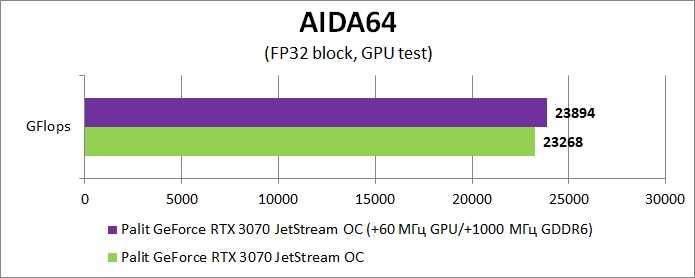
Рендеринг сцены в Cinebench R15 силами графического ускорителя позволяет получить солидную оценку, а разгон RTX 3070 JetStream OC только улучшает результат.
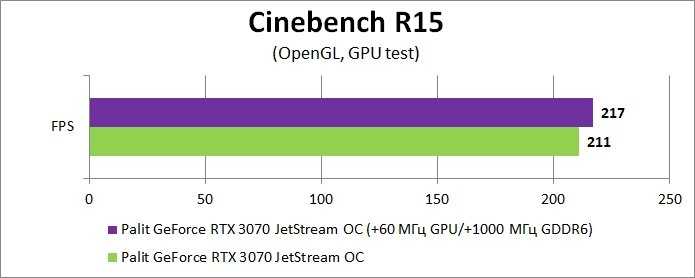
Стандартная сцена в V-Ray обрабатывается с помощью RTX 3070 JetStream OC за 36 секунд на штатных частотах. Разгон видеокарты позволяет сократить время выполнения задачи еще на три секунды.
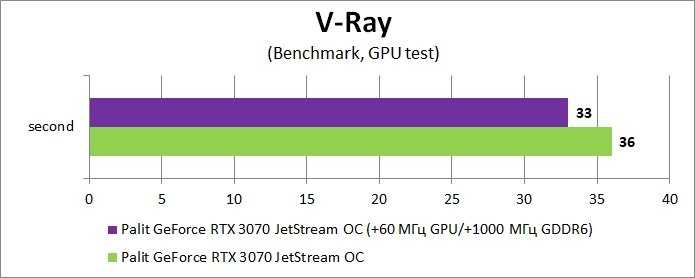
Теперь посмотрим на графическую производительность RTX 3070 JetStream OC в популярном бенчмарке 3D Mark. Используем пару самых нагруженных тестов TimeSpy Extreme и Port Royal. Эффект от разгона видеокарты есть и особенно заметен в тесте с задействованной технологией Ray tracing.

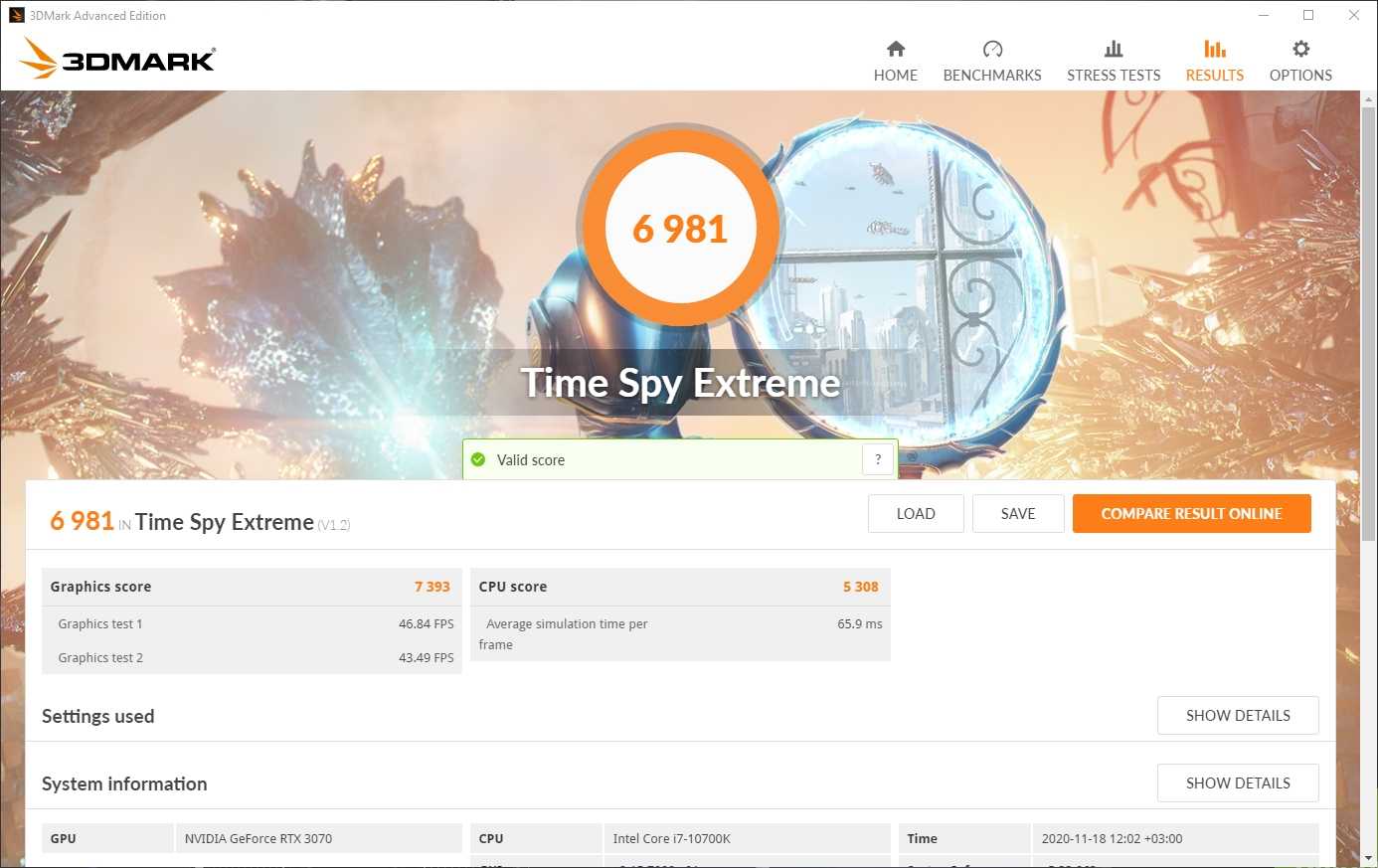
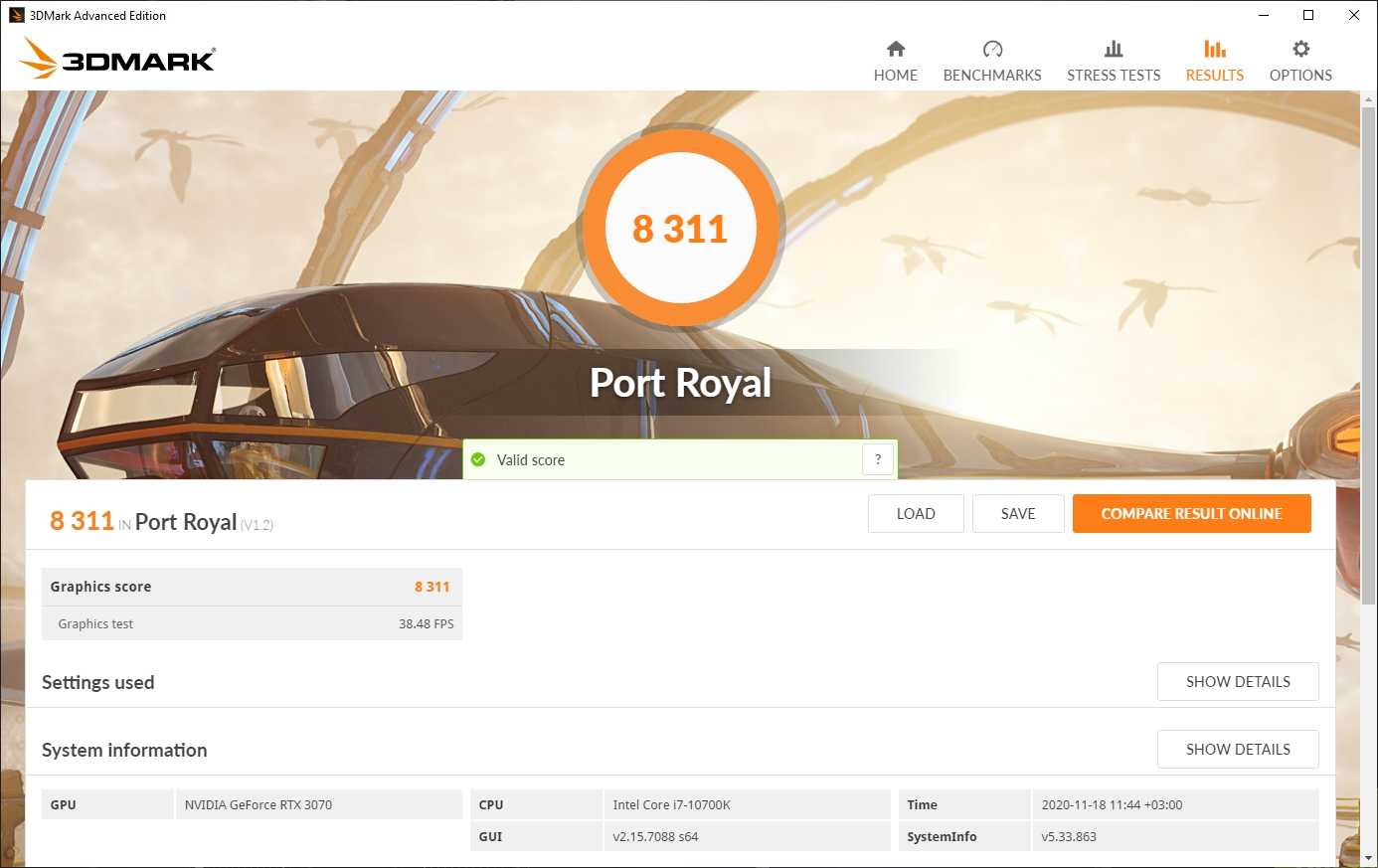
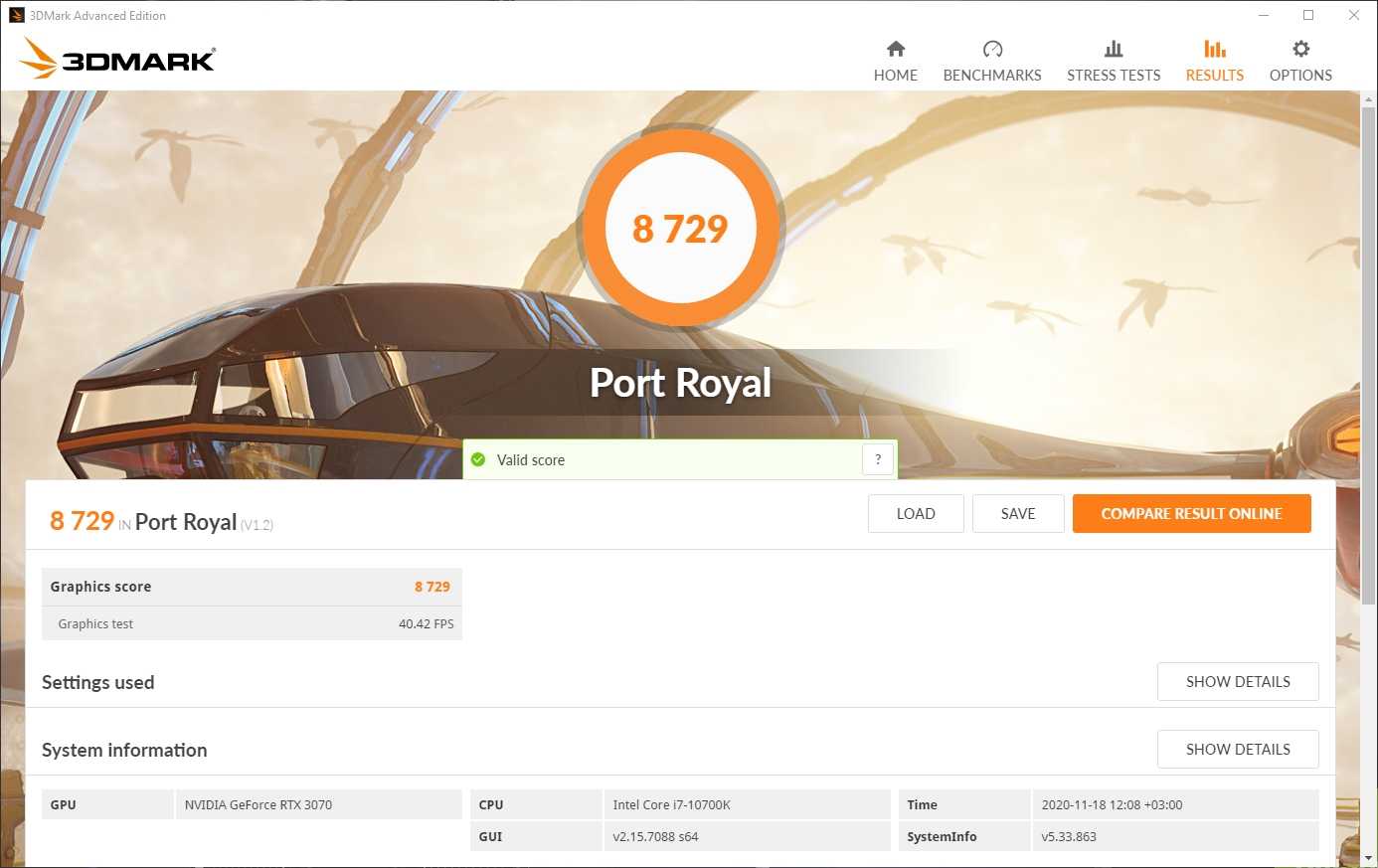
Также посмотрим на работу технологии DLSS на видеокарте RTX 3070 JetStream OC. Ее использование приводит к двукратному росту FPS в разрешении 2560 х 1440.

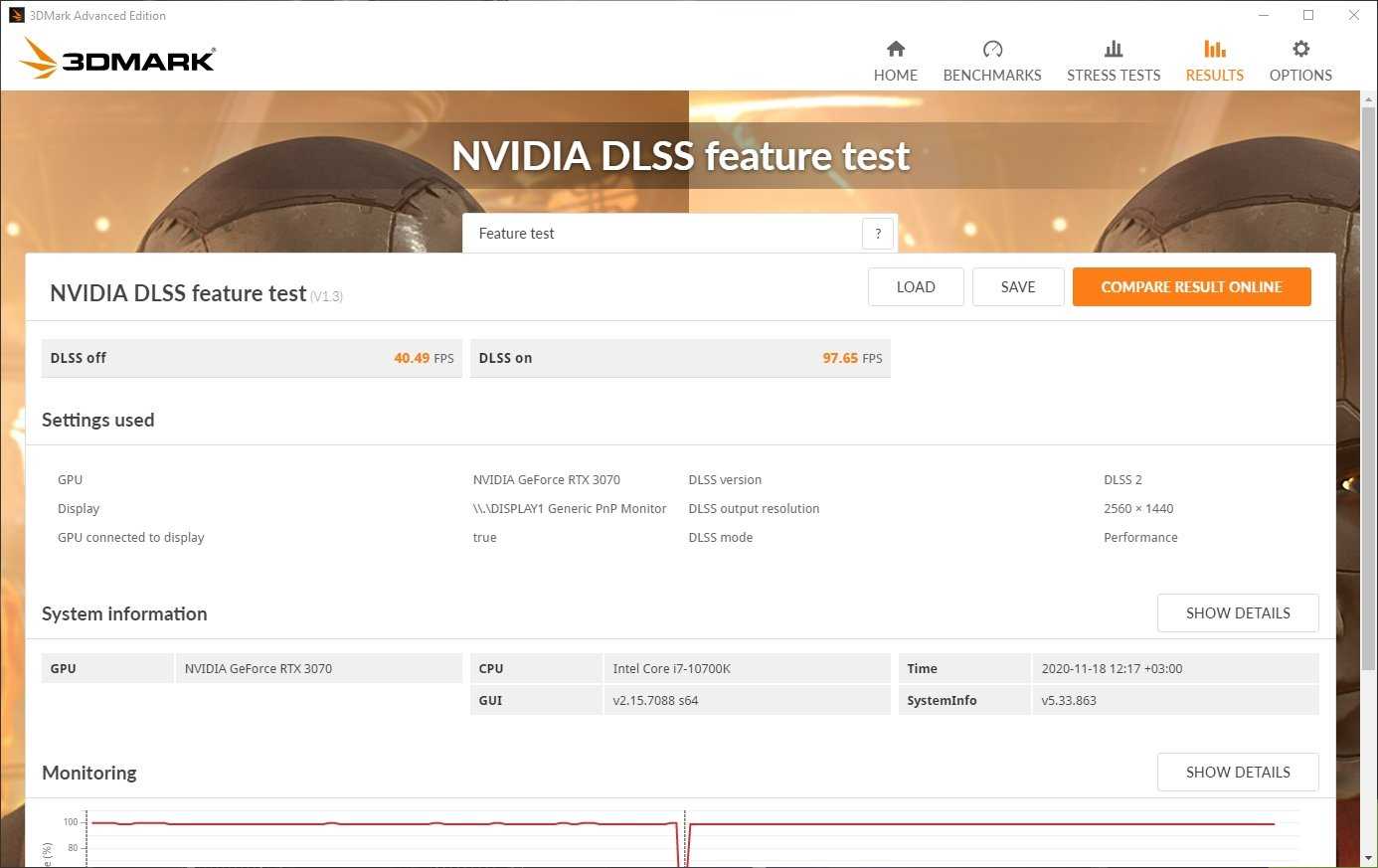
И наконец тесты RTX 3070 JetStream OC в реальных играх. Здесь мы позволили себе включить графические настройки на максимум. Помимо штатных пресетов Ultra, если игра позволяла, были активированы предельно высокие опции теней, качество текстур и прочее. В играх, поддерживающих технологии Ray tracing и DLSS, данные опции также были активированы. Видеокарта RTX 3070 JetStream OC была протестирована в разрешениях 4K (3840×2160 DSR), 2K (2560×1440 DSR) и FullHD (1920×1080).
Far Cry 5
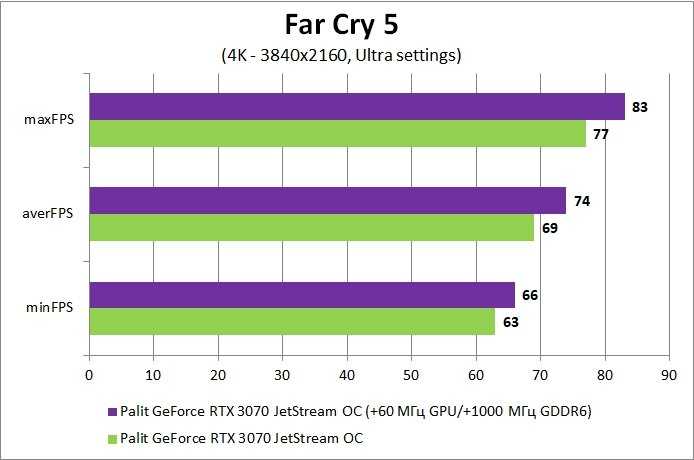
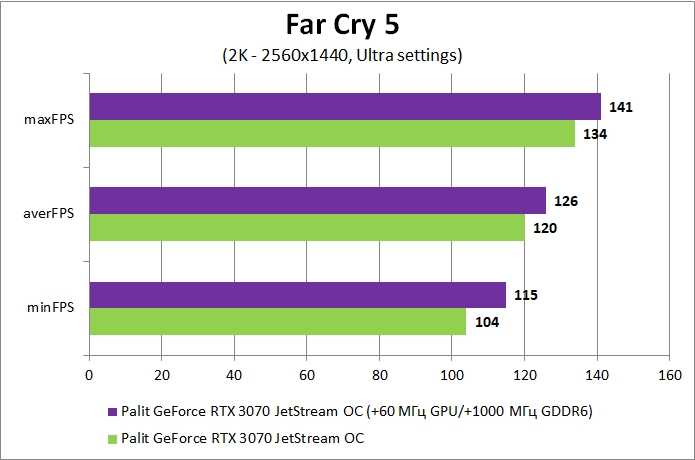
 Shadow of the Tomb Raider
Shadow of the Tomb Raider
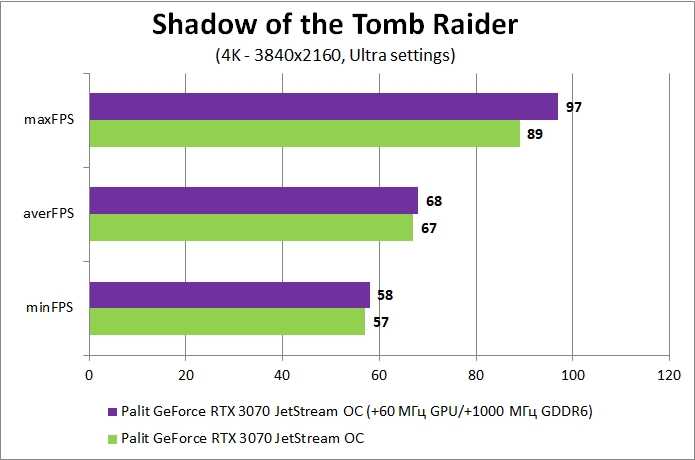
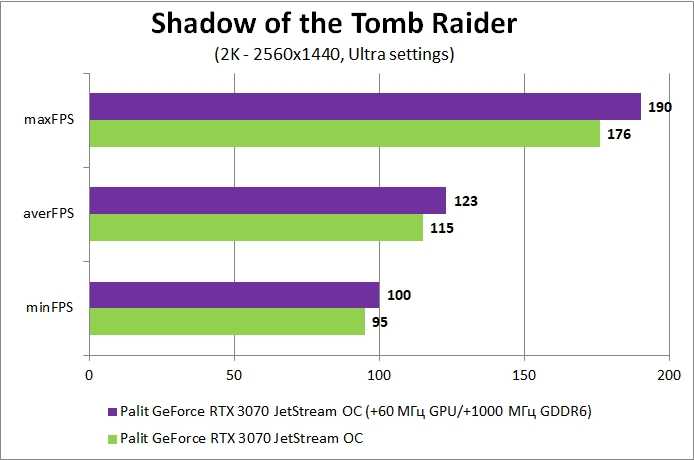
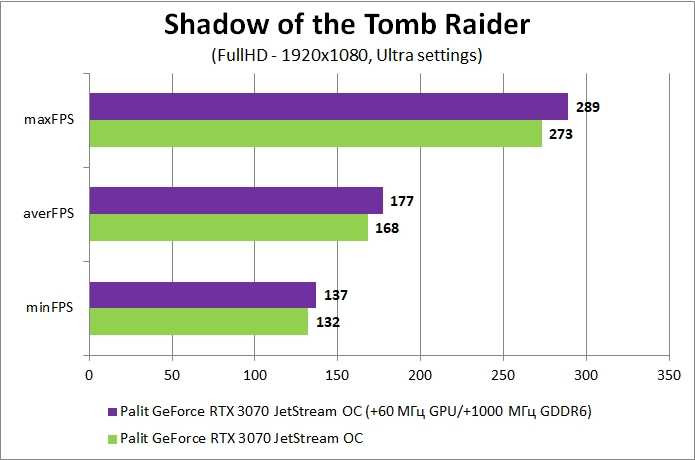 Wolfenstein: Youngblood
Wolfenstein: Youngblood
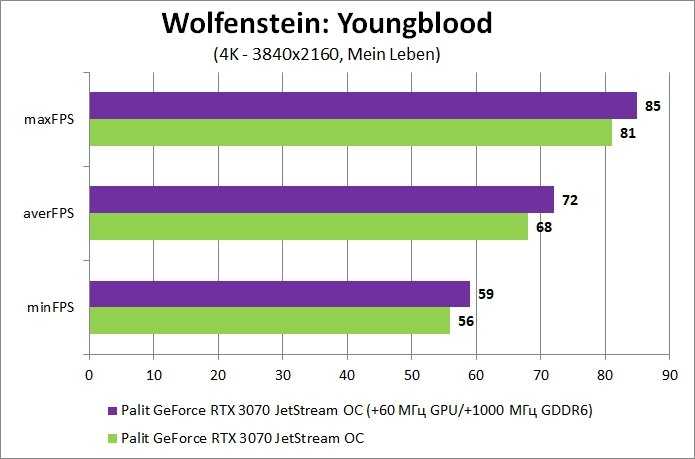
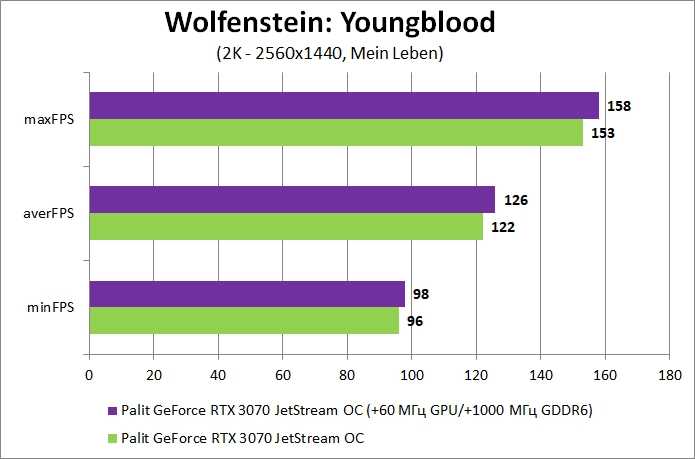
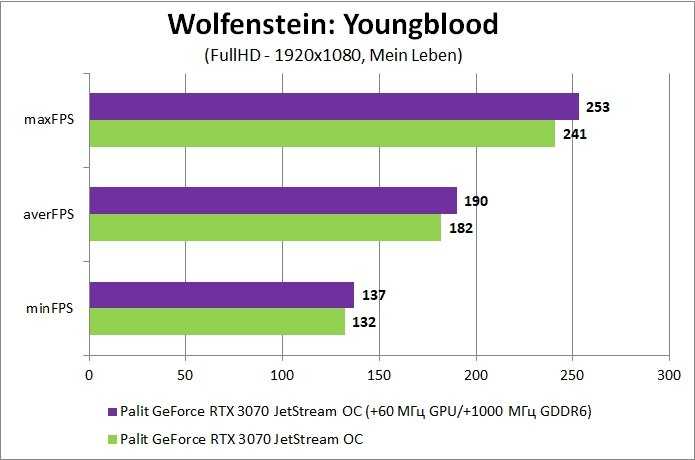 Red Dead Redemption II
Red Dead Redemption II
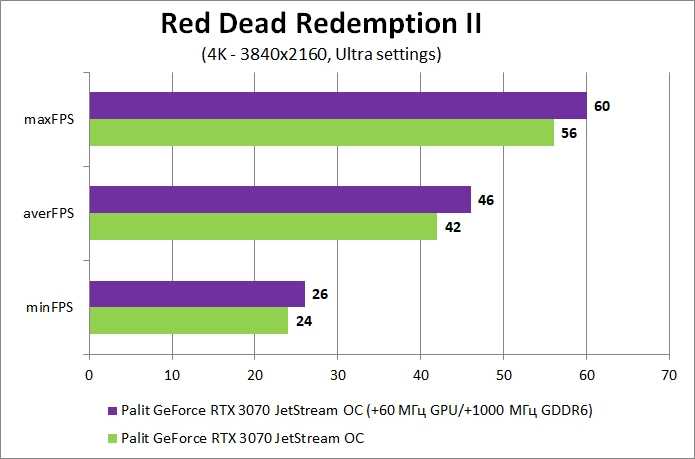
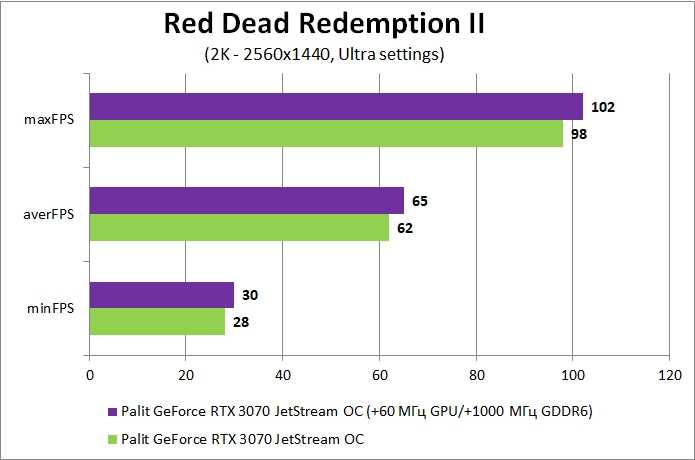
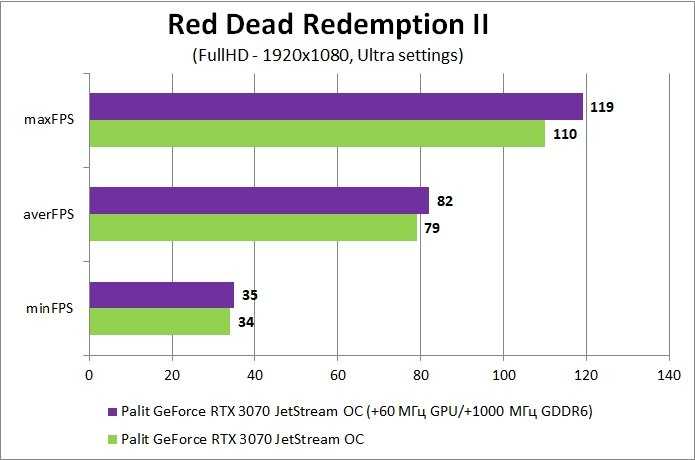 Metro Exodus
Metro Exodus
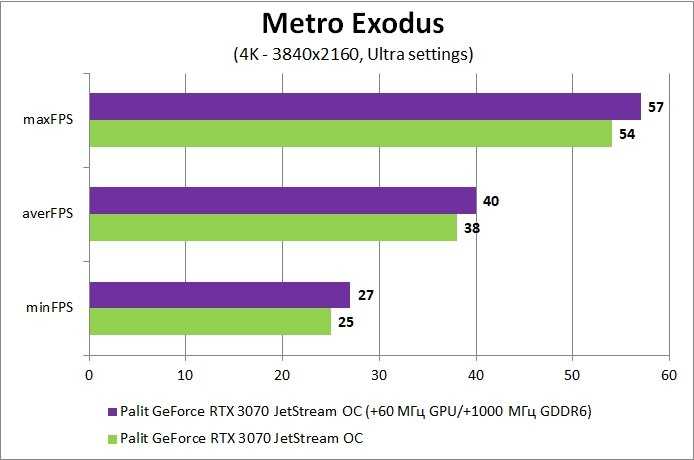
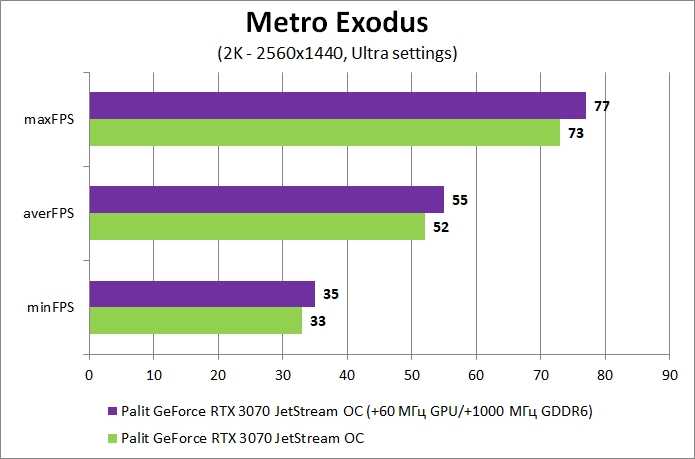
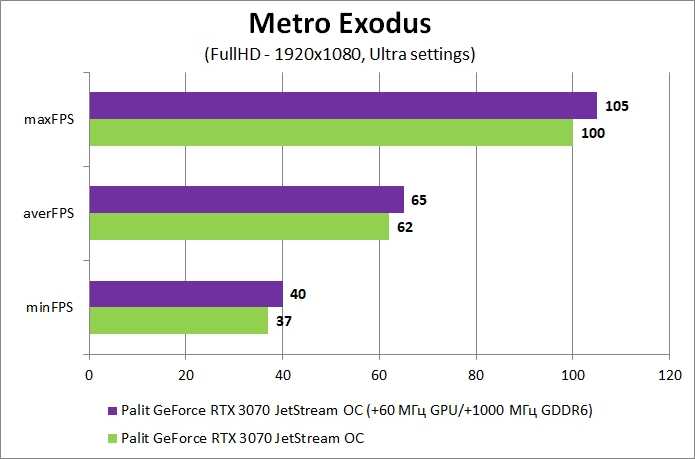
Компания NVIDIA позиционирует видеокарту RTX 3070 как решение для 2К гейминга. Однако наше тестирование RTX 3070 JetStream OC показало, что этому графическому ускорителю вполне под силу и 4К гейминг в некоторых игровых проектах. Возможно, в каких-то особо ресурсоемких играх настройки графики придется немного понизить, то все равно играть в 4К на RTX 3070 JetStream OC вполне реально. Что же касается игр в 2К разрешении, то в этих условиях видеокарта чувствует себя весьма уверенно. Почти во всех игровых проектах средний FPS переваливает на психологические 60 кадров/сек, и это при максимально возможных ультра-настройках.
⇡#Выводы
Сама по себе GeForce GTX 960 – это не более чем замена GTX 760 с более низким энергопотреблением и себестоимостью. Близкие по производительности видеокарты AMD – Radeon R9 280 и R9 285. Первый представитель «красного» лагеря в среднем на тысячу–другую дешевле, второй стоит примерно столько же, сколько и GTX 960.
Предназначен GTX 960 в первую очередь для разрешения 1920 × 1080. При таком разрешении даже в самых требовательных играх он обеспечивает хотя бы минимально приемлемую частоту смены кадров (30 FPS), а если нет – добрать недостающее поможет разгон. Впрочем, режимы с ресурсоемким сглаживанием (MSAA, SSAA) все-таки тяжеловаты для GTX 960. Лучше отключить эти излишества, оставив детализацию на максимуме. Разрешение 2560 × 1440 дается GTX 960 с трудом: в самых тяжелых играх придется пожертвовать детализацией, не говоря уже о полноэкранном сглаживании.
Самая прокачанная версия GeForce GTX 960 от Palit на поверку оказалась довольно простой и добротной видеокартой. В конструкции нет ничего лишнего, но того, что есть, вполне достаточно для поддержания высоких частот, установленных по умолчанию, при минимальном уровне шума. Да и потенциал дополнительного разгона нас не разочаровал
Что не менее важно, видеокарты Palit занимают нижние места по ценам среди аналогов, и GeForce GTX 960 Super JetStream также оказывается заметно дешевле более навороченных конкурентов с сопоставимыми частотами






























